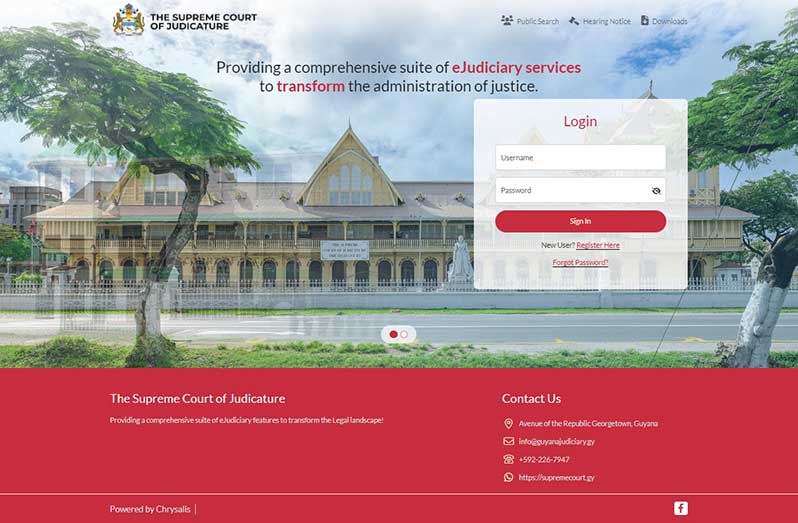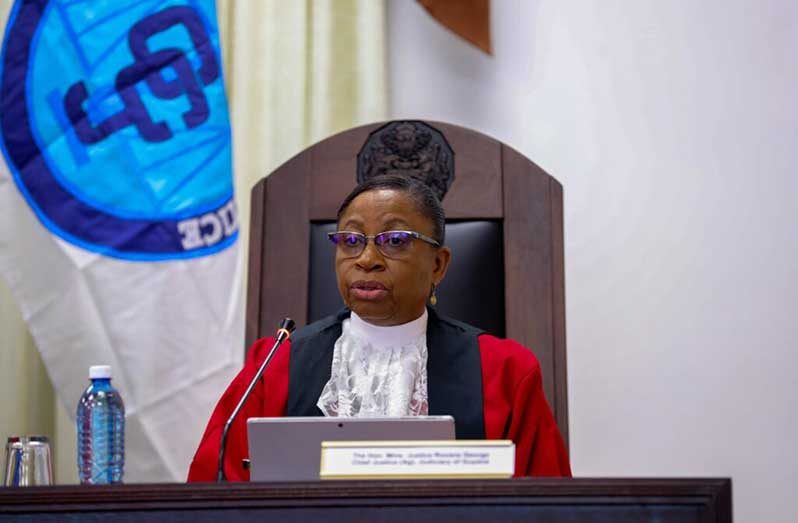–Chief Justice hails it as a ‘seamless game-changer for the administration of justice’
GUYANA’S judiciary has undergone a significant transformation through the implementation of a complete e-litigation system, resulting in enhanced efficiency, transparency, and accessibility in the administration of justice. The Acting Chief Justice emphasised the benefits of this ground-breaking initiative during the 2025 Law Year opening ceremonies at the Georgetown Victoria Law Courts on Tuesday. Implemented last year, the e-litigation system aims to fully digitise all facets of the judicial process, encompassing the submission of legal documentation, case tracking, and judgment delivery.
Designed to alleviate the chronic delays and inefficiencies long associated with the traditional paper-based system, this digital platform has already garnered significant attention for its innovative approach. “Our first major win in the implementation of the [Supreme Court’s Strategic Plan 2024-2031] has been the successful roll out of the e-litigation system for the Court of Appeal, the Full Court and the High Court,” said Chief Justice (ag) Roxane George-Wiltshire, SC.
She stated that the e-litigation system was introduced for the Court of Appeal on January 30, 2024. By December 31, 2024, a total of 311 appeals and applications had been filed through the e-litigation portal. She reported that the e-litigation system was implemented for the Full Court and High Court across all three counties—Essequibo, Berbice, and Demerara—on October 4, 2024. Justice George-Wiltshire stated, “From October 4 to December 31, 2024, 37 appeals were filed in the Full Court, and 1,637 cases were filed in the High Court.” These are categorised as follows: 1,373 cases in Demerara, 377 cases in Berbice, and 76 cases in Essequibo.
GREATER INTEGRATION OF ADR
Acknowledging the high volume of case filings, the Chief Justice once again encouraged individuals to settle disputes through alternative dispute resolution (ADR) methods, such as mediation and restorative justice. Last year, a total of 19 judicial officers were appointed, comprising 10 High Court judges and nine magistrates. “Despite the increase in the number of judicial officers, the court system cannot realistically conduct trials in every case or deliver judgment within the four-month timeframe prescribed by law [Time Limit for Judicial Decisions Act] due to the heavy caseload dealt with by each civil judge,” she emphasised.
GAMECHANGER
Despite ongoing minor issues, Justice George-Wiltshire boasted that the transition to the e-litigation system has been a “seamless game-changer for the administration of justice.”

The legal fraternity has largely welcomed the new system, lauding it as a step forward in enhancing judicial efficiency. Attorneys-at-law have highlighted how the e-litigation platform has reduced their workloads and improved access to case-related information.
Moreover, one of the most significant benefits of the e-litigation system is its potential to enhance access to justice, particularly for individuals in remote areas. She said lawyers and litigants alike, as well as judicial officers and the staff at the various courts registries, have adapted to the new system with enthusiasm. “Since November 2024, lawyers have been able to file from their offices and have been filing at a phenomenal rate. Self-represented litigants will continue to file through service bureaus and lawyers can access the bureaus for assistance.”
She noted that the ad-hoc committee of the Rules Committee is currently reviewing the Civil Procedure Rules to ensure they are aligned with the new e-litigation system.
She accepted that one of the challenges has been the issuance of court orders, stating: “We are actively working to ensure the timely issuance of court orders. However, we have reverted to lawyers being responsible for producing draft orders for approval by the judges. [Once approved], the orders can be uploaded to the [e-litigation] portal either by the lawyers or the registry.”
The Chief Justice highlighted that the e-litigation platform provides several features designed to improve judicial efficiency. These include the automatic assignment of cases to judges, email notifications for judges, lawyers, and litigants, as well as the ability for judges to track their case-disposition rates and assess the ratio of filed cases to those completed.
“It can generate detailed reports, enabling a more accurate measurement of the performance of the Supreme Court. These capabilities will support improved planning and budgeting for the judiciary as more data is generated and analysed,” she added. In the criminal jurisdiction, she revealed that the filing of indictments—a formal charge or accusation of a serious crime—on the portal is set to begin in the first quarter of 2025. The draft Criminal Procedure Rules have been finalised and are awaiting review by the Rules Committee. Justice George-Wiltshire noted: “These rules will provide for more robust case management and greater efficiency in the adjudication of criminal cases, with the overriding objective of having cases dealt with in a very timely manner.”
OTHER DEVELOPMENTS
She emphasised that the Supreme Court has bolstered its Verbatim Court Reporting Unit as part of its efforts to move away from relying on manually taken trial notes by judicial officers as the official court record. While it is still a work in progress, she said the system is designed to serve the Court of Appeal, Full Court, High Court, and numerous magistrate’s courts. Both audio and written transcripts are now accessible, reducing the need to solely rely on notes taken by judicial officers, particularly for cases of national interest, Justice George-Wiltshire added.
She noted that some judicial officers are utilising the artificial intelligence feature of Zoom to assist with court records, though it is not considered the official record.
While still “a work in progress,” she stated that the case-management system for the magistrate’s courts will continue to be implemented throughout this year. Additionally, to further enhance efficiency in court administration, she said, “We are establishing electronic human resources and inventory
management systems.” In closing, the Chief Justice extended gratitude to several stakeholders who contributed to the integration of technology into the court system.
In addition to the Chief Justice, attendees included members of the diplomatic corps, judges of the High Court and Court of Appeal, magistrates, Solicitor General Nigel Hawke, President of the Bar Association of Guyana, Kamal Ramkarran and other members of the Bar.



.jpg)








